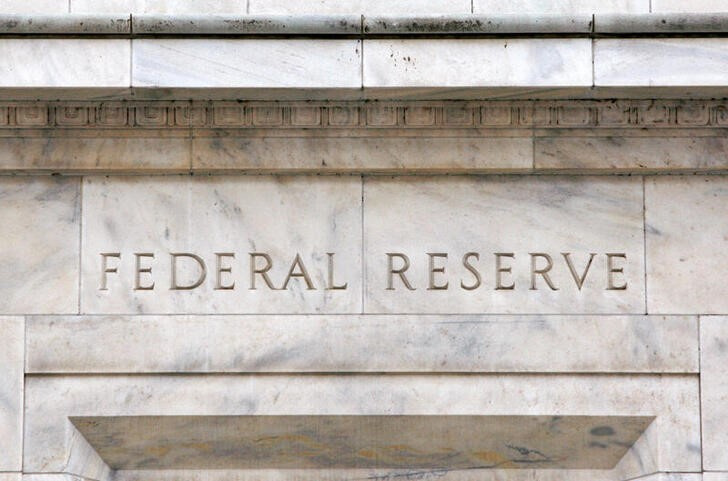By Mike Dolan
LONDON (Reuters) -If the U.S. Federal Reserve tends to tighten hard until something breaks, as some investors still believe despite the central bank's denials, then it may have heard an unnerving crunch.
The Fed's favoured bond market measure of a coming recession just cracked.
The Fed has raced to jack up interest rates this year to get across an inflation surge spurred by a Russia-related energy shock - and will do so again next week. And there's been no shortage of financial turbulence, market liquidity scares, domestic housing stress and dollar pressures in the interim.
But despite endless handwringing that the monetary squeeze will brew up a recession, U.S. economic growth stayed fairly resilient through the third quarter of this year and the labour market remains pretty robust.
For all the understandable angst, that's not yet the sort of 'pain' Fed chair Jerome Powell reckoned may be necessary to drag inflation back down to target. And the most recent monthly readings of 'core' inflation were not encouraging.
Although the unfolding corporate earnings season is bumpy, consensus forecasts on high-frequency economic data have been proving too gloomy if anything. U.S. economic 'surprises' are still firmly in positive territory.
And yet markets are now doggedly clinging to the idea that the Fed is about to slow the pace of its jumbo 75 basis point interest rate rises after it delivers a fourth straight hike of that magnitude next week.
Futures now price a smaller 50 bp rise for December and the implied Fed 'terminal rate' next year has recoiled by about a quarter point to less than 4.8% over the past week. A down shift in the rate hiking pace by the Bank of Canada this week just stoked that speculation.
Ten-year Treasury yields have retreated a whopping 40 bps since last Friday and the U.S. dollar has come off the boil. And even in the face of some spooky corporate health warnings, stock markets fed off Fed 'pivot' talk yet again and have been chomping at the bit for a fortnight.
It may all be wishful thinking again of course - far from the first time this year. The absence of Fed speakers, in their traditional public blackout period before next week's meeting, means there's no official pushback.
But one metric that may have encouraged investors to bet again on some light at the end of 2022's dark tunnel is an inversion of part of the U.S. Treasury yield curve the Fed claims to prefer when assessing the risk of recession ahead.
INVERSION DIVERSION
Many investors typically look at the gap between two- and 10-year yields as a predictor of future activity, where inversion of long rates below shorter ones has frequently preceded past economic contractions by about 18 months.
When that 2-10 yield curve inverted in April for the first time in almost three years - shortly after the Fed's first hike - recession angst took a firm grip. Even though the curve steepened again quickly for a few months, a deeper and more durable inversion resumed from July onwards.
The biggest market worry was the Fed did not care - or at least it didn't agree - and it used other measures instead to show it had plenty of room to tighten further and stay focussed on inflation alone.
Fed economists argued vociferously that the 2-10 yield curve was not reliable and insisted a 'soft landing' was still possible if more accurate shorter-term yield curve spreads that remained positive were used instead.
That changed this week.
An elongated measure of the yield curve between 3 months and 10 years - used by the New York Fed in its recession probability models - dropped into negative territory for the first time since the pandemic hit.
In a blog in March called '(Don't Fear) The Yield Curve' Fed Board economists Eric Engstrom and Steven Sharpe dismissed the obsession with a 2-10 year inversion and reckoned near forward rate spreads between 3-month borrowing rates and implied 3-months rates 18 months hence were much more accurate over time.
Although comfortably positive back then, these near term spreads have also turned negative this month and the implied 3-month rate for 18 months time fell below current 3-month rates for the first time in more than a decade.
While confirmation of recession ahead may seem like cold comfort to investors, it may also allow the Fed to assume that it's now gaining enough traction to sap inflation and ease its foot off the brake, a little.
Morgan Stanley (NYSE:MS) economists cautioned their clients not to conflate any reduction in the pace of Fed hikes with less appetite to get policy rates higher. But they too expect the Fed to "indicate that it could soon be appropriate to step down the pace of hikes" and see only a 50 bp rise in December.
The opinions expressed here are those of the author, a columnist for Reuters.
(by Mike Dolan, Twitter: @reutersMikeD. Reporting by Nell Mackenzie; Editing by Kirsten Donovan)
